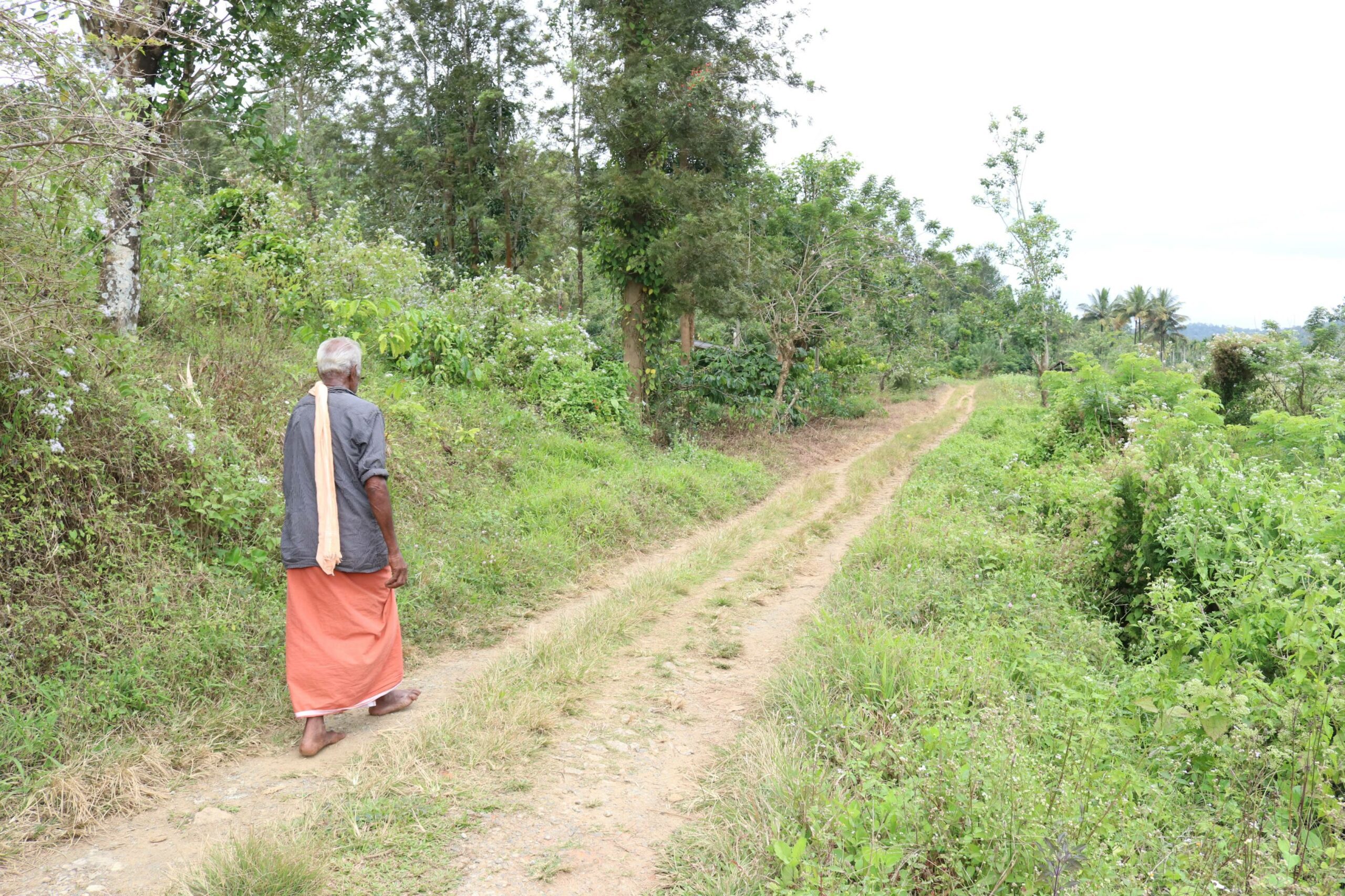The Congress-led opposition UDF uses the murky situation to regain the lost trust of the influential Catholic Church.

Chettiyalathur, a village adjacent to the forest, in Wayanad. (KA Shaji)
Trouble is brewing for the ruling LDF in the high ranges of Kerala — this time over the creation of one-kilometre Eco-Sensitive Zones (ESZs) around reserve forests, national parks and wildlife sanctuaries.
Alleged inaccuracies and lack of clarity in a “hastily” prepared preliminary satellite survey report on human habitations in ESZs have led to a consolidation of farmers across the state, threatening to spoil the LDF’s political fortunes.
What’s more, the bishops of the influential Catholic Church have come out in the open against the creation of buffer zones around protected forests.
The Opposition Congress-led UDF, meanwhile, is seeking an opportunity to win back its lost Christian vote bank, much to the chagrin of the LDF.
Senior Congress leader Ramesh Chennithala on Tuesday, 20 December, accused the government of cheating the farmers.
“The concerns of the Church should be taken seriously,” he said while demanding a statement from the chief minister.
The report, prepared using a remote sensing satellite, was published on 12 December and the general public and organisations can register their grievances over it till Friday, 23 December.
The report has sparked widespread resentment among farmers in districts such as Idukki, Wayanad, Kozhikode, Pathanamthitta, Kannur and Malappuram.
They are fearing displacement and loss of livelihood once the ESZs are established.
Bishop Mar Remigiose Inchananiyil of the Thamarassery diocese said farmers will fight against their possible displacement.
“The farmers, who have survived many harsh situations, will not be scared by the guns and lathis of the police. If the ESZ is implemented, lakhs of families and several religious and educational institutions will be affected,” he told South First.
“The Left government seems to be callous and lethargic. They will have to pay the price,” he added.
The Catholics constitute a significant section of Kerala’s Christians, who account for 18.4 percent of the state’s population. Their political preferences often decide the future of the rival fronts.
Interestingly, the CPI(M) and LDF had earlier benefitted from the Church’s stand on an environmental issue. The Church had led an agitation against the recommendations of the Western Ghats Ecology Expert Panel (WGEEP) headed by environmentalist Madhav Gadgil.
The WGEEP had recommended the government to declare 37 percent of the Western Ghats as ecologically fragile and ban commercial activities in those areas.
The Congress was then in power both at the Centre and state. The CPI(M) supported the Church-led farmers’ agitation, resulting in the Congress losing the trust of the Church leadership.
Subsequently, the Kerala Congress (Mani) snapped its decades-long ties with the UDF and joined the LDF. The Kerala Congress (M) is a pro-Catholic, pro-farmer political organisation.
Ten years after the anti-Gadgil report agitation, the CPI(M) now finds itself at the receiving end of the Church’s anger. The UDF has shed its pro-environment image temporarily to win back its Catholic vote base and is fuelling the buffer-zone controversy against the ruling alliance.
With the bishops adopting an aggressive, confrontational stand against Chief Minister Pinarayi Vijayan and his government for the “inept” handling of the buffer zone issue, the Kerala Congress (M) has turned defensive.
The Syrian Catholics are more powerful than the Latin Catholic Church that spearheaded the recent, and unsuccessful, protests against the Vizhinjam seaport project. No political front can afford to antagonise them.
According to the satellite survey findings, around 50,000 buildings close to the 23 protected forests in the state would have to be demolished.

Farmer Krishnan Chetty with his livestock at Chettiyalathur, a village abutting the forest in Wayanad. (KA Shaji)
The Church and the UDF claimed that the actual number of buildings that would be double the number of structures mentioned in the report.
The survey report prepared by the Kerala State Remote Sensing and Environment Centre on behalf of the Forest Department is allegedly riddled with mistakes. Several areas far away from forests have been wrongly demarcated as buffer zones in the report, critics said.
The trouble for the ruling LDF began when the Supreme Court directed all states and Union territories to set up buffer zones around protected forests. Each state was given the right to decide the radius of the zones.
The Kerala government assigned the State Remote Sensing and Environment Centre to identify the existing structures in buffer zones. Additionally, it also formed an expert committee under former chief justice of West Bengal, Justice Thottathil B Radhakrishnan, to study the proposed ESZs.
The survey identified human settlements and structures in 115 village panchayats abutting the protected forests.
The Justice Radhakrishnan committee set a 23 December deadline for farmers to report those structures that have been excluded from the survey report published on the government website on 12 December. The tight deadline coupled with the confusing report angered the farmers, sparking massive protests across the state.
The agitators accused the government of adopting dubious means to create buffer zones. The Church, too, joined in, criticising the report and the expert committee.
The farmers in the 115 forest-fringe village panchayats complained that the survey did not reflect the ground reality and their villages would not fall under the buffer zones.
They believe that severe restrictions would be imposed on all economic activities in buffer zones, including curbs on constructing or repairing houses.
Additionally, the villagers expressed fear that they would be forced to evict in future.
Sensing danger, the Pinarayi Vijayan government has decided to set up help desks at every panchayat that would be affected. It also said the deadline for filing grievances, too, would be extended.
The Church, however, refused to relent. It has called for organising massive protests in the coming days.
Bishop Inchananiyil said that the Church would launch a street march in the hilly regions, demanding the withdrawal of the survey report and the exclusion of all farmlands from the proposed buffer zones.
Meanwhile, the Kerala Catholic Bishops Council (KCBC), comprising all Catholic bishops in the state, has also decided to support the farmers.
The council’s president Major Archbishop Cardinal Mar Baselios Cleemis Catholicose told South First that the government should have allayed the farmers’ fears.
“The boundaries of the buffer zones should not extent beyond the forests. The protests by farmers are spontaneous, and nobody has the authority to blame them,” he said.
Kerala’s Forest Minister AK Saseendran, meanwhile, termed the agitation called by the KCBC “unfortunate”. He felt that the Church leaders must desist from all political agitations.
“Instead of leading agitations, they must cooperate with the government. The tenure of the expert committee would be extended for hearing the grievances of all the affected people,” he said.
According to the Union government’s National Wildlife Action Plan, areas located within 10 km of the boundaries of all national parks, wildlife sanctuaries and reserve forests must be notified and protected as eco-fragile zones or ESZs.
While the 10-km rule is general, states can decide on the radius of the zones.
Amidst sharp criticism and threats of agitations, the Kerala government has called for a high-level meeting on the buffer zone issue.
Chief Minister Pinarayi Vijayan called the meeting, scheduled for Tuesday, 20 December, afternoon.
The state ministers of Revenue, Forest, Finance and Local Self Government institutions and respective top officials would attend the meeting.
The meeting would discuss the issue of determining the extent of the ESZs around protected forests and wildlife sanctuaries.
A government source confirmed the convening of the meeting, a decision that came hours after the Congress announced that it would be holding public agitations similar to those held against the SilverLine project, across the state on the buffer zone issue, PTI reported.
Earlier in the day, the Congress said the agitations would be held if the Left government does not set aside its alleged “indifference” and address the concerns of the people.
According to the guidelines issued by the Union Ministry of Environment in 2011, ESZs are “shock absorbers”, meant to protect forests from the negative impact of activities in the nearby areas.
Additionally, these areas are meant to act as transition zones to strike a balance between areas requiring higher protection and those requiring lesser or little protection.
Interestingly, the guidelines stated that the ESZs are not aimed at hampering the daily activities of people living in the vicinity but to conserve the protected areas and “refine the environment around them”. The guidelines did not speak about evicting people.
On 3 June, while hearing a Public Interest Litigation seeking to protect the forests in the Nilgiris district in Tamil Nadu, a three-member bench of the Supreme Court ordered the creation of the buffer zones across the country.
In its judgment, the court directed all states to have a mandatory 1 km ESZ from the demarcated boundaries of all the protected forest lands, wildlife sanctuaries and national parks.
The court also stated that no new permanent structure or mining should be permitted within the ESZ.
Due to the high human population density close to the notified protected areas in Kerala, farmers’ groups and political parties demanded the exemption of all human settlements in the state from the ESZ.
Alex Ozhukayil, chairman of the Kerala Independent Farmers’ Association (KIFA), felt that the court’s ruling would severely impact the farmers’ livelihoods.
“Unlike other states, Kerala has a high population density and farmers have been inhabiting most forest fringes for a long time. Imposing restrictions on their normal life in the name of conservation will not be entertained,” he asserted.
Ozhukayil said wildlife sanctuaries in Kerala are spread over eight lakh acres. If ESZs of one-kilometre radius are created outside the boundaries of each forest, more than four lakh acres of farmlands will be affected.
Interestingly, activists of the CPI(M)’s student wing SFI attacked Congress leader Rahul Gandhi’s office in Wayanad in the last week of June, accusing him of inaction on the buffer zone issue.
Legal experts had them said that the local MP could do nothing on the issue and that the state government should file a review petition in the court.
(With PTI inputs)

Apr 25, 2024

Apr 25, 2024

Apr 24, 2024

Apr 24, 2024

Apr 24, 2024

Apr 23, 2024